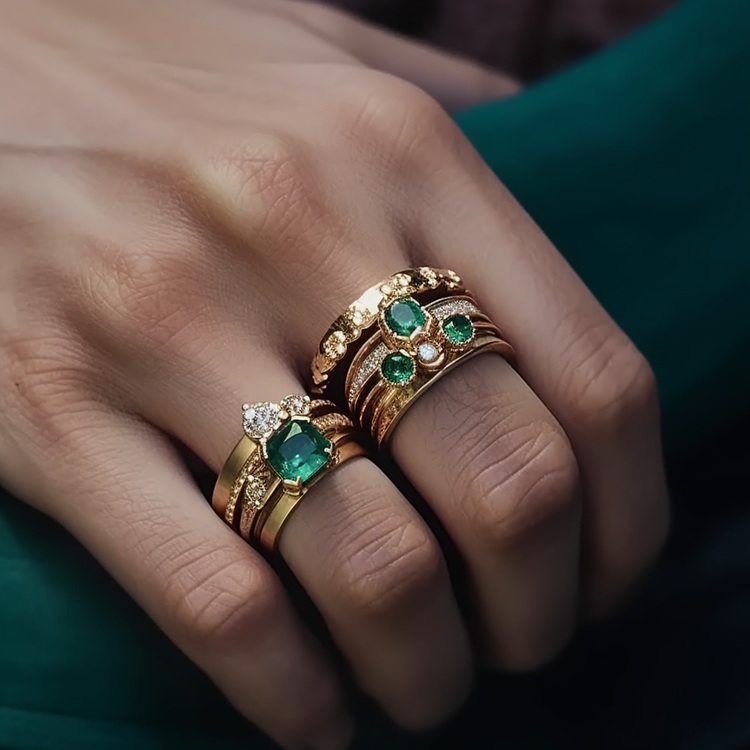A Guide to Women's Rings: Types, Materials, and Fashion Trends
Rings have adorned women's hands for centuries, serving as both fashion statements and symbolic treasures. These circular accessories have evolved from simple metal bands to elaborate designs featuring precious stones and intricate craftsmanship. Understanding the various types, materials, and design elements of women's rings can help anyone make more informed choices when selecting these timeless accessories.

Rings have been cherished adornments throughout human history, dating back thousands of years when they were crafted from materials like bone, wood, and eventually precious metals. Today, women’s rings serve multiple purposes—from symbols of commitment and status to expressions of personal style. The right ring can elevate an outfit, complement other jewelry pieces, and make a lasting impression. With countless designs, materials, and settings available, women’s rings offer endless possibilities for personal expression and style enhancement.
What Types of Rings Are Popular Among Women?
Women’s ring collections typically feature several distinct categories, each serving different purposes and occasions. Engagement rings, often featuring diamonds or other precious gemstones in solitaire, halo, or three-stone settings, symbolize commitment and future marriage. Wedding bands, typically simpler in design, represent the eternal bond of matrimony and are worn daily. Promise rings serve as pre-engagement tokens of affection or commitment between partners.
Beyond relationship-signifying rings, fashion or statement rings allow for creative expression without symbolic attachment. These can range from minimalist bands to bold cocktail rings featuring large gemstones or artistic designs. Signet rings, traditionally engraved with family crests, have evolved into personalized accessories featuring initials or meaningful symbols. Stackable rings have gained popularity for their versatility, allowing wearers to combine multiple thin bands for a customized look that can change daily.
What Materials Are Commonly Used in Women’s Rings?
The materials used in women’s rings vary widely, with precious metals forming the foundation of most designs. Gold remains a perennial favorite, available in yellow, white, and rose varieties, each offering different aesthetic appeals and complementing various skin tones. Sterling silver provides an affordable yet elegant alternative with its bright white luster, though it requires regular polishing to prevent tarnishing. Platinum, while more expensive, offers exceptional durability and a naturally white finish that doesn’t fade or change color over time.
Alternative metals like titanium and stainless steel have gained popularity for their strength, lightweight nature, and hypoallergenic properties. For gemstones, diamonds continue to dominate the market, especially for engagement rings, valued for their brilliance and durability. Colored gemstones like sapphires, rubies, emeralds, and semi-precious stones like amethyst, topaz, and citrine offer vibrant alternatives. Modern rings also incorporate materials like ceramic, wood, and even recycled materials for eco-conscious consumers seeking sustainable options.
How Do Rings Complement Fashion and Outfits?
Rings serve as versatile accessories that can either harmonize with an ensemble or provide striking contrast. When coordinating rings with outfits, consider both the metal tone and overall design aesthetic. Yellow gold typically complements warm colors and earth tones, while white metals like silver, white gold, and platinum pair beautifully with cool colors and monochromatic palettes. Rose gold offers versatility, working well with both warm and cool tones while adding a romantic, feminine touch.
Minimalist rings with clean lines enhance professional attire without overwhelming the look, while statement rings with bold designs or colorful gemstones can elevate simple outfits by serving as focal points. When layering multiple rings, mixing metals has become increasingly acceptable in modern fashion, creating dynamic, personalized combinations. Consider proportions when selecting rings—larger hands can carry substantial designs, while more delicate hands might be better suited to refined, thinner bands. For special occasions, rings with sparkle and dimension add glamour to evening wear, while everyday rings should balance style with practicality for comfort during daily activities.
What Are the Current Trends in Women’s Ring Designs?
Contemporary ring designs reflect broader jewelry trends while incorporating innovative elements. Vintage-inspired rings have seen a resurgence, featuring Art Deco geometric patterns, Victorian-era intricate detailing, or Edwardian filigree work. These designs often incorporate modern twists for relevance to today’s aesthetics. Minimalist rings with clean lines and subtle details appeal to those preferring understated elegance, focusing on quality craftsmanship rather than ornate embellishments.
Gemstone arrangements have evolved beyond traditional settings, with toi et moi (“you and me”) rings featuring two stones side by side gaining popularity. East-west settings, where oval or emerald-cut stones are positioned horizontally rather than vertically, offer fresh perspectives on classic designs. Sustainability has become increasingly important, with recycled metals, lab-grown diamonds, and ethically sourced gemstones appealing to environmentally conscious consumers.
Customization options have expanded dramatically, allowing for personalized engravings, birthstone inclusions, or completely bespoke designs that tell individual stories. Smart rings with technological capabilities represent the cutting edge, incorporating features like fitness tracking, contactless payments, or notification alerts while maintaining stylish appearances.
How Should Women Select and Care for Their Rings?
Selecting the perfect ring involves considering several factors beyond aesthetic appeal. Ring size fluctuates with temperature, time of day, and other physiological factors, so measurements should be taken when hands are at a neutral temperature, typically in the afternoon. Lifestyle considerations matter significantly—active lifestyles may require more durable designs with secure settings, while those working with their hands might prefer lower-profile rings that won’t catch on materials.
Proper care extends the life and beauty of rings. Regular cleaning with mild soap and warm water using a soft brush removes accumulated dirt and oils that diminish sparkle. Professional cleaning and inspection annually ensures settings remain secure and identifies potential issues before stones become loose. Storage considerations include keeping rings separate from other jewelry to prevent scratching, and removing rings during activities involving chemicals, rough surfaces, or extensive water exposure.
For those with metal sensitivities, hypoallergenic options like platinum, titanium, or high-karat gold minimize reaction risks. Understanding the Mohs hardness scale helps inform gemstone choices—softer stones like opals or pearls require gentler handling than diamonds or sapphires. With proper selection and care, women’s rings can remain beautiful heirlooms for generations, combining personal significance with enduring craftsmanship.




